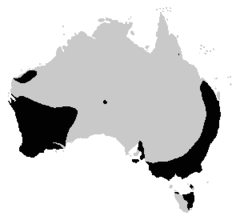Pseudophryne
| Pseudophryne[1] | |||
| Fitzinger, 1843[2] | |||
 Przedstawiciel rodzaju – P. coriacea | |||
| Systematyka | |||
| Domena | |||
|---|---|---|---|
| Królestwo | |||
| Typ | |||
| Podtyp | |||
| Gromada | |||
| Rząd | |||
| Nadrodzina | Myobatrachoidea | ||
| Rodzina | |||
| Rodzaj | Pseudophryne | ||
| Typ nomenklatoryczny | |||
Bombinator australis J.E. Gray, 1835 | |||
| Synonimy | |||
| Gatunki | |||
| |||
| Zasięg występowania | |||
(c) Froggydarb, CC-BY-SA-3.0 | |||
Pseudophryne – rodzaj płaza bezogonowego z rodziny żółwinkowatych (Myobatrachidae).
Zasięg występowania
Rodzaj obejmuje gatunki występujące w południowej i wschodniej Australii[6].
Systematyka
Etymologia
- Pseudophryne: gr. ψευδος pseudos „fałszywy”[7]; φρυνη phrunē, φρυνης phrunēs „ropucha”[8].
- Bufonella: łac. bufo, bufonis „ropucha”[9]; łac. przyrostek zdrabniający -ella[10]. Gatunek typowy: Bufonella crucifera Girard, 1853 (= Bombinator australis J.E. Gray, 1835).
- Kankanophryne: καγκανος kankanos „suchy”; φρυνη phrunē, φρυνης phrunēs „ropucha”[4]. Gatunek typowy: Pseudophryne occidentalis Parker, 1940.
- Gradwellia: Norman Alfred Gradwell, australijski herpetolog[5]. Gatunek typowy: Pseudophryne major Parker, 1940.
Podział systematyczny
Do rodzaju należą następujące gatunki[6]:
- Pseudophryne australis (Gray, 1835) – korobora jaskrawogłowa[11]
- Pseudophryne bibronii Günther, 1859
- Pseudophryne coriacea Keferstein, 1868
- Pseudophryne corroboree Moore, 1953
- Pseudophryne covacevichae Ingram & Corben, 1994
- Pseudophryne dendyi Lucas, 1892
- Pseudophryne douglasi Main, 1964
- Pseudophryne guentheri Boulenger, 1882
- Pseudophryne major Parker, 1940
- Pseudophryne occidentalis Parker, 1940
- Pseudophryne pengilleyi Wells & Wellington, 1985
- Pseudophryne raveni Ingram & Corben, 1994
- Pseudophryne robinsoni Donnellan, Mahony & Bertozzi, 2012
- Pseudophryne semimarmorata Lucas, 1892
Przypisy
- ↑ Pseudophryne, [w:] Integrated Taxonomic Information System [online] (ang.).
- ↑ L.J.F.J. Fitzinger: Systema reptilium. Fasciculus primus, Amblyglossae. Vindobonae: Braumüller et Seidel, 1843, s. 32. (łac.)
- ↑ Ch.F. Girard. Descriptions of new species of reptiles, collected by the U.S. Exploring Expedition, under the command of Capt. Charles Wilkes, U.S.N. Second part—including the species of batrachians, exotic to North America. „Proceedings of the Academy of Natural Sciences of Philadelphia”. 6, s. 424, 1853.
- ↑ a b W.R. Heyer & D.S.S. Liem. Analysis of the intergeneric relationships of the Australian frog family Myobatrachidae. „Smithsonian Contributions to Zoology”. 233, s. 12, 1976 (ang.).
- ↑ a b R.W. Wells & C.R. Wellington. A classification of the Amphibia and Reptilia of Australia. „Australian Journal of Herpetology”. Supplementary Series. 1, s. 2, 1985 (ang.).
- ↑ a b D. Frost: Pseudophryne Fitzinger, 1843 (ang.). W: Amphibian Species of the World 6.0, an Online Reference [on-line]. American Museum of Natural History. [dostęp 2020-01-29].
- ↑ Jaeger 1944 ↓, s. xvii.
- ↑ Jaeger 1944 ↓, s. 173.
- ↑ Jaeger 1944 ↓, s. 35.
- ↑ Jaeger 1944 ↓, s. 75.
- ↑ Praca zbiorowa: Zwierzęta: encyklopedia ilustrowana. Warszawa: Wydawnictwo Naukowe PWN, 2005, s. 432. ISBN 83-01-14344-4.
Bibliografia
- E.C. J Jaeger: Source-book of biological names and terms. Wyd. 1. Springfield: Charles C. Thomas, 1944, s. 1–256. (ang.)
Media użyte na tej stronie
Autor: (of code) -xfi-, Licencja: CC BY-SA 3.0
The Wikispecies logo created by Zephram Stark based on a concept design by Jeremykemp.
Autor: LiquidGhoul, edited by Fir0002, Licencja: CC BY-SA 3.0
A Red-backed Toadlet (Pseudophryne coriacea)



